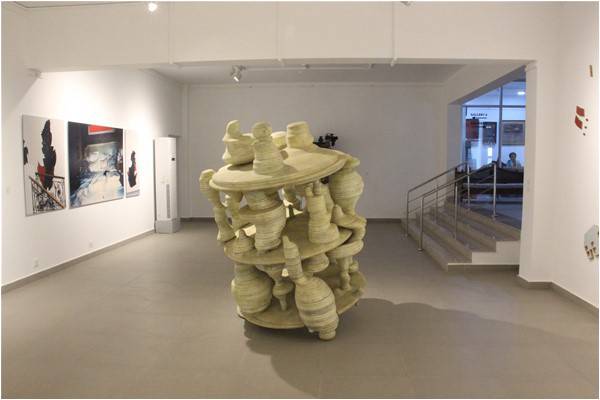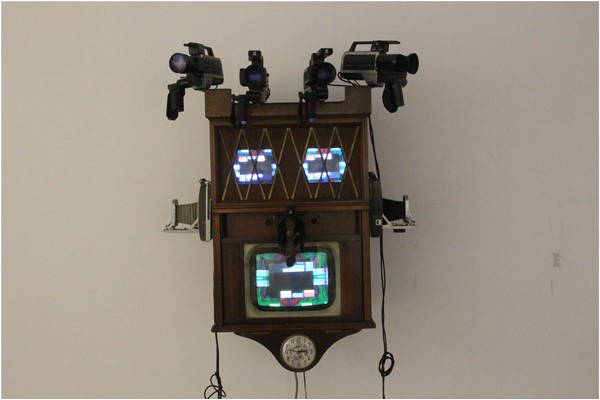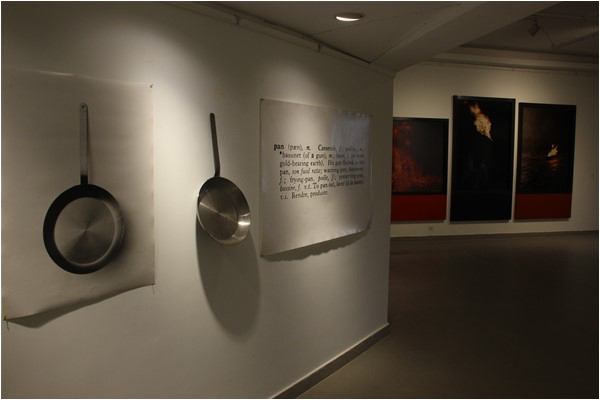
Europe, like many of the world’s regions have been growing closer together – though with the refugee crisis and the Brexit catastrophe/calamity who can tell what will happen eventually to European unity?- In any case, the fact is that contemporary art has been at the forefront of the unifying process. Its international aspect is clearly demonstrated by art events that are increasingly prepared for a worldwide public, and losing more and more of their national imprint in the process.
Whereas many German artists moved to Paris in the 1950s, or to New York in the 1960s, since then many artists from other countries have moved to Germany to practise their art. They have given new impulses which are today seen as an integral part of the German art scene, and put their stamp on creative life, together with their colleagues. Some of them teach at art schools, making them attractive not only to German youngsters but to those from abroad as well.

‘Artspace Germany’ is the first exhibition from that country put together as a transnational form, based on the foreign and cultural policy of the European Union. It includes the work of 14 artists –from the UK, South Africa, Switzerland, the Netherlands, Turkey, Denmark, the USA, Korea, Czechoslovakia, Belgium, Australia, Italy and Poland. They belong to the first generation of artists who decided voluntarily to live and work in Germany. The exhibition was presented at V.M. Gallery, Karachi, under the capable and talented hands of director Riffat Alvi, who has made a name for the gallery by holding large-scale foreign and international shows there. Well do art lovers remember the First Print Biennial 2014, a print show like never before, in which 150 artists both local and foreign participated.
The work on display in ‘Artspace Germany’ includes sculpture, paintings, photography and installations, by Sir Anthony Douglas Cragg, Armando, Marianne Eigenheer, Christine Hill, Candice Breitz, Magdalena Jetelovna, Per Kirkenby, Joseph Kosuth, Marie-Jo Lafontaine, Simone Mangos, Guiseppe Spagnulo, Warzinee Tokarski, Herman de Vries and Nam June Paik. This is a travelling show, moving from country to country, and it arrived in Karachi from Mumbai. Germany used to be known for a rather inward looking attitude to art. To this extent, ‘Artspace Germany’ is the precise opposite of an art exhibition perceived territorially or in terms of national character. The artists selected represent a large number of similarly distinguished figures in the art world.
One of the world’s foremost sculptors, the British Tony Cragg as he likes to be called, moved to Germany in 1972. Constantly exploring new relations between people and the material world, he says, “I see a material or an object as having a balloon of information around it.” His laminated plastic sculpture, titled ‘Flotsam,’ a fluid mass of globular organic shapes, answers to this description. It is presented at a seemingly precarious angle, but is cleverly balanced. What it lacks in colour it makes up for in ingenuity. The piece has a life of its own, as opposed to the number of fearfully intellectual pieces in the exhibition. In the 1980s, Cragg became acclaimed for his sculptures of found objects, fragments of furniture, household items of different materials, plastic toys and so on. These were often chosen for their colour, and when laid out on the floor or fixed to the wall, created and portrayed forms recognisable from everyday life.
Korean-American Nam June Paik was born in Seoul and studied the history of art and of music in the University of Tokyo, where he gained a B.A. in aesthetics. Known as ‘the father of video art,’ his revolutionary practice laid the groundwork for today’s artists working in new media art. His ideas have come full circle with the rise of Facebook and Youtube, the online platforms that draw billions of users. What is more, his vast array of installations, videotapes, global television productions, films and television performances has reshaped our perceptions of the temporal image in contemporary art. The Director of the Smithsonian American Art Museum has said, “If Picasso was astride the first half of the 20th century, Nam Jun Paik is the centre of gravity of all that was its second half.”
His amazing piece titled ‘Internet Dwellers’ is composed entirely of technology, showing three TV. screens, a TV cabinet, four video cameras, a microscope, two polaroid cameras, a laserdisc player, a clock and an original Paik laserdisc. It can be seen as a reminder of views on technology from the past, and looks like a futuristic, friendly robot and also as something like the old wall telephones that graced our homes before the advent of the now ubiquitous desk models and mobile phones.

Ayse Erkmen, originally from Turkey, presents conceptual art – formulating experiences on the frontiers of art. Her works concentrate the material and intellectual qualities and their possible structures and meanings. Her piece titled ‘Here and There’ consists of 16 trapezoid metal bodies of varying colour and forms, in two extremely different arrangements. In one case, every element has to occupy its predetermined place in a semicircle. It has been said that “relating the work to a wall suggests possible completion as a closed circle outside the exhibition space.” The other arrangement shows the individual pieces scattered about randomly, filling up the exhibition space entirely with complete chaos. This work was inspired by the tiling in the Macka Sanat Galleris in Istanbul. Somehow it reminds one of the much-used educational building kit jigsaws created for children, though it is done in the spirit of ‘arte povera,’ an Italian movement from the mid-20th century in which poor quality everyday materials – even newspapers – were used as a protest against the commercialisation of art.
Quite the opposite to all this is Dutch artist Armando’s black and white painting titled ‘Flag,’ showing a burning flag, reminiscent of the WW2 German occupation of the Netherlands, and his upbringing close to a concentration camp. Armando tells us that one should not write or paint what one knows, but the things that lie hidden between knowing and understanding. This may also be said of his piece titled ‘Woods.’ Both, emblem and colour, make a gloomy impact on the viewer through motif and colour choice. For this artist one could say that there are probably no landscapes or emblems that do not carry a burden. The pathos in these pieces and in the painter’s words touches our hearts.
Meanwhile American-born Joseph Kosuth generally strives to explore the nature of art, rather than producing what is traditionally called ‘art.’ His pronouncement on art is quite incredible, for he says, “Works of art are analytical propositions. That is, viewed within their context – as art – they provide no information whatsoever about any matter of fact. A work of art is a tautology in that it is a presentation of the artist’s intention – that that particular work of art is art, which means that it is a presentation of art. Thus, that it is art is a priori – so if someone calls it art, then it is art.” His pronouncement implies that all artworks are equivalent in their meaninglessness. This contradicts our experience, and also his own art practice and other writings. His two photographic pieces shown at V.M. Gallery and titled ‘Pan’ are interesting in that they turn a commonplace object into a work of art – something often done by artists, but in his case, he displays the dictionary meaning of ‘Pan,’ for example, as part of each piece. This is a favourite trick of his, one which first made him famous in his native America. The shadows, and the nature of the paper used in the work displaying a pair of pans – one dull and one shiny – add interest to the work, giving it a character which may otherwise be seen as yet another fearfully intellectual work of art.
Apart from what Kosuth tells us, there are so many different ideas as to what art actually is. One could say that it is the fusion of multiple ideas into a single, corporeal thought that influences the senses and inspires the self (and hopefully the viewer). And, of course, an artist is the opposite of a reformer, though many are idealists. The artist does not tinker with the universe but recreates it out of one’s own experiences and understanding of life. Thus we have so many different experiences and understandings displayed in ‘Artspace Germany,’ the unifying factor being the quality of work displayed by so many who have made Germany their home and their studio.
Whereas many German artists moved to Paris in the 1950s, or to New York in the 1960s, since then many artists from other countries have moved to Germany to practise their art. They have given new impulses which are today seen as an integral part of the German art scene, and put their stamp on creative life, together with their colleagues. Some of them teach at art schools, making them attractive not only to German youngsters but to those from abroad as well.

‘Artspace Germany’ is the first exhibition from that country put together as a transnational form, based on the foreign and cultural policy of the European Union. It includes the work of 14 artists –from the UK, South Africa, Switzerland, the Netherlands, Turkey, Denmark, the USA, Korea, Czechoslovakia, Belgium, Australia, Italy and Poland. They belong to the first generation of artists who decided voluntarily to live and work in Germany. The exhibition was presented at V.M. Gallery, Karachi, under the capable and talented hands of director Riffat Alvi, who has made a name for the gallery by holding large-scale foreign and international shows there. Well do art lovers remember the First Print Biennial 2014, a print show like never before, in which 150 artists both local and foreign participated.
The work on display in ‘Artspace Germany’ includes sculpture, paintings, photography and installations, by Sir Anthony Douglas Cragg, Armando, Marianne Eigenheer, Christine Hill, Candice Breitz, Magdalena Jetelovna, Per Kirkenby, Joseph Kosuth, Marie-Jo Lafontaine, Simone Mangos, Guiseppe Spagnulo, Warzinee Tokarski, Herman de Vries and Nam June Paik. This is a travelling show, moving from country to country, and it arrived in Karachi from Mumbai. Germany used to be known for a rather inward looking attitude to art. To this extent, ‘Artspace Germany’ is the precise opposite of an art exhibition perceived territorially or in terms of national character. The artists selected represent a large number of similarly distinguished figures in the art world.
'Artspace Germany' is the precise opposite of an art exhibition perceived territorially or in terms of national character
One of the world’s foremost sculptors, the British Tony Cragg as he likes to be called, moved to Germany in 1972. Constantly exploring new relations between people and the material world, he says, “I see a material or an object as having a balloon of information around it.” His laminated plastic sculpture, titled ‘Flotsam,’ a fluid mass of globular organic shapes, answers to this description. It is presented at a seemingly precarious angle, but is cleverly balanced. What it lacks in colour it makes up for in ingenuity. The piece has a life of its own, as opposed to the number of fearfully intellectual pieces in the exhibition. In the 1980s, Cragg became acclaimed for his sculptures of found objects, fragments of furniture, household items of different materials, plastic toys and so on. These were often chosen for their colour, and when laid out on the floor or fixed to the wall, created and portrayed forms recognisable from everyday life.
Korean-American Nam June Paik was born in Seoul and studied the history of art and of music in the University of Tokyo, where he gained a B.A. in aesthetics. Known as ‘the father of video art,’ his revolutionary practice laid the groundwork for today’s artists working in new media art. His ideas have come full circle with the rise of Facebook and Youtube, the online platforms that draw billions of users. What is more, his vast array of installations, videotapes, global television productions, films and television performances has reshaped our perceptions of the temporal image in contemporary art. The Director of the Smithsonian American Art Museum has said, “If Picasso was astride the first half of the 20th century, Nam Jun Paik is the centre of gravity of all that was its second half.”
His amazing piece titled ‘Internet Dwellers’ is composed entirely of technology, showing three TV. screens, a TV cabinet, four video cameras, a microscope, two polaroid cameras, a laserdisc player, a clock and an original Paik laserdisc. It can be seen as a reminder of views on technology from the past, and looks like a futuristic, friendly robot and also as something like the old wall telephones that graced our homes before the advent of the now ubiquitous desk models and mobile phones.

Ayse Erkmen, originally from Turkey, presents conceptual art – formulating experiences on the frontiers of art. Her works concentrate the material and intellectual qualities and their possible structures and meanings. Her piece titled ‘Here and There’ consists of 16 trapezoid metal bodies of varying colour and forms, in two extremely different arrangements. In one case, every element has to occupy its predetermined place in a semicircle. It has been said that “relating the work to a wall suggests possible completion as a closed circle outside the exhibition space.” The other arrangement shows the individual pieces scattered about randomly, filling up the exhibition space entirely with complete chaos. This work was inspired by the tiling in the Macka Sanat Galleris in Istanbul. Somehow it reminds one of the much-used educational building kit jigsaws created for children, though it is done in the spirit of ‘arte povera,’ an Italian movement from the mid-20th century in which poor quality everyday materials – even newspapers – were used as a protest against the commercialisation of art.
Quite the opposite to all this is Dutch artist Armando’s black and white painting titled ‘Flag,’ showing a burning flag, reminiscent of the WW2 German occupation of the Netherlands, and his upbringing close to a concentration camp. Armando tells us that one should not write or paint what one knows, but the things that lie hidden between knowing and understanding. This may also be said of his piece titled ‘Woods.’ Both, emblem and colour, make a gloomy impact on the viewer through motif and colour choice. For this artist one could say that there are probably no landscapes or emblems that do not carry a burden. The pathos in these pieces and in the painter’s words touches our hearts.
Meanwhile American-born Joseph Kosuth generally strives to explore the nature of art, rather than producing what is traditionally called ‘art.’ His pronouncement on art is quite incredible, for he says, “Works of art are analytical propositions. That is, viewed within their context – as art – they provide no information whatsoever about any matter of fact. A work of art is a tautology in that it is a presentation of the artist’s intention – that that particular work of art is art, which means that it is a presentation of art. Thus, that it is art is a priori – so if someone calls it art, then it is art.” His pronouncement implies that all artworks are equivalent in their meaninglessness. This contradicts our experience, and also his own art practice and other writings. His two photographic pieces shown at V.M. Gallery and titled ‘Pan’ are interesting in that they turn a commonplace object into a work of art – something often done by artists, but in his case, he displays the dictionary meaning of ‘Pan,’ for example, as part of each piece. This is a favourite trick of his, one which first made him famous in his native America. The shadows, and the nature of the paper used in the work displaying a pair of pans – one dull and one shiny – add interest to the work, giving it a character which may otherwise be seen as yet another fearfully intellectual work of art.
Apart from what Kosuth tells us, there are so many different ideas as to what art actually is. One could say that it is the fusion of multiple ideas into a single, corporeal thought that influences the senses and inspires the self (and hopefully the viewer). And, of course, an artist is the opposite of a reformer, though many are idealists. The artist does not tinker with the universe but recreates it out of one’s own experiences and understanding of life. Thus we have so many different experiences and understandings displayed in ‘Artspace Germany,’ the unifying factor being the quality of work displayed by so many who have made Germany their home and their studio.

